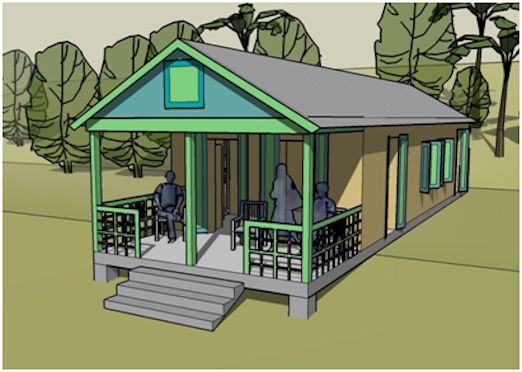Kay Haitian Housing
THE KAY: A HAITIAN TRANSITIONAL HOUSE PLAN
Patti Stouter, landscape architect 3/19/2010
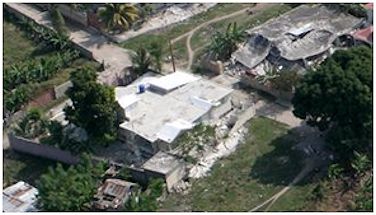 Earthbag is an inexpensive and simple material that ‘fits’ Haiti’s cultural strengths and available resources. One example llustrates its use for transitional housing in a traditional Haitian house form.
Earthbag is an inexpensive and simple material that ‘fits’ Haiti’s cultural strengths and available resources. One example llustrates its use for transitional housing in a traditional Haitian house form.
Safer Buildings for Haiti
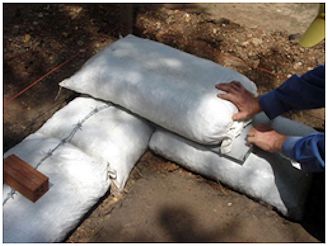 In Haiti simpler building materials are safer. Construction processes that use affordable materials and are understandable to the ordinary person will be less subject to
In Haiti simpler building materials are safer. Construction processes that use affordable materials and are understandable to the ordinary person will be less subject to
dangerous cost-cutting.
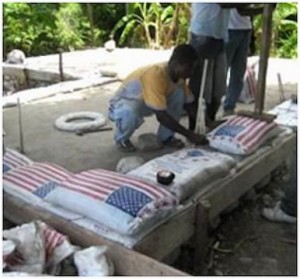 Earthbag is a form of geo-textile building construction that is growing in popularity around the world. It’s cheap and weathers quakes well. Recent engineering tests prove earthbag to be stronger than traditional stud walls.i And an orphanage building (shown above and at right) completed of it last year near Port au Prince for Free the Kids was undamaged by the recent earthquakes.
Earthbag is a form of geo-textile building construction that is growing in popularity around the world. It’s cheap and weathers quakes well. Recent engineering tests prove earthbag to be stronger than traditional stud walls.i And an orphanage building (shown above and at right) completed of it last year near Port au Prince for Free the Kids was undamaged by the recent earthquakes.
I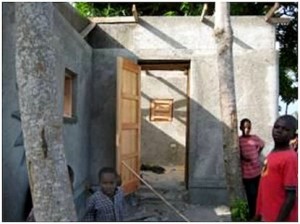 nexpensive materials form earthbag walls. Grain bags are filled with moist earth, stacked, tamped, and covered with plaster. Under roofs they dry into an improved adobe with tensile strength from fabric, barbed wire, and mesh.
nexpensive materials form earthbag walls. Grain bags are filled with moist earth, stacked, tamped, and covered with plaster. Under roofs they dry into an improved adobe with tensile strength from fabric, barbed wire, and mesh.
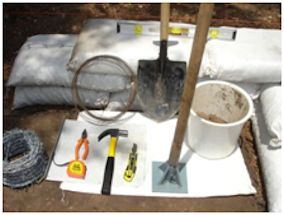
Earthbag building is easily understood and created with simple rules of thumb. Openings must be kept certain distances apart, long walls need piers or temporary bracing. The whole structure is tied together with a conventional cement bond beam or one of steel pipes or corrugated metal strips tied into the wall below.
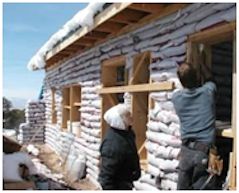 Overall it is a labor intensive process using hand tools. This simple and visually obvious process works well for one-story buildings, but can easily support upper levels.
Overall it is a labor intensive process using hand tools. This simple and visually obvious process works well for one-story buildings, but can easily support upper levels.
Haitian Buildings
Many of the familiar building forms of Haiti are suited to both the climate and the culture. Yet, even a traditional building will create a dismaying cookie- cutter neighborhood if mass-produced.
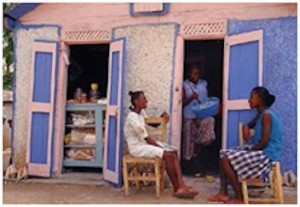 Aid ‘must rely heavily upon the voices and underlying cultural ground-rules of those being aided.’ We need local input at every stage, and willingness to change plans to try ‘what may at first appear to be unworkable solutions.’ii
Aid ‘must rely heavily upon the voices and underlying cultural ground-rules of those being aided.’ We need local input at every stage, and willingness to change plans to try ‘what may at first appear to be unworkable solutions.’ii
The best way to avoid mass-production and misunderstanding by distant planners is to enable Haitian designers, planners, and builders to solve housing needs. Empower many small contractors and home-owners to build for themselves.
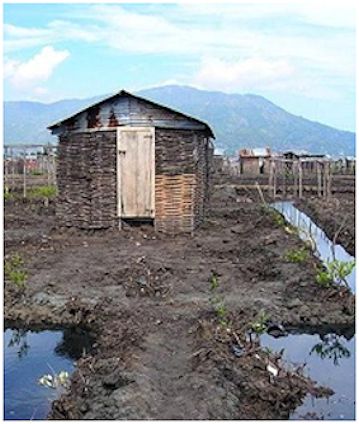 ‘Little by little the bird builds its nest.’
‘Little by little the bird builds its nest.’
The detached house is a basic of Haitian culture because it symbolizes adulthood as well as allowing needed ventilation along side walls. The ti-kay is the simplest form, and provides a good example of how a simple transitional shelter can grow into an appropriate Haitian house.
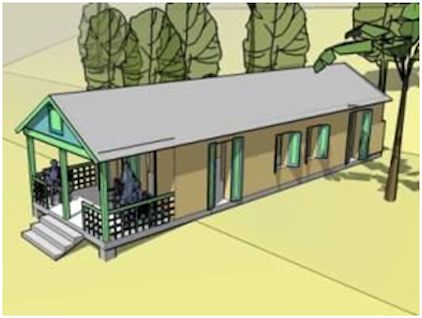 A kay is a long, narrow building (like the shotgun houses in the US which probably developed from it). Each room opens into the next without any hallways, allowing good cross-ventilation. It is easy to add on to, by extending the same rooflines.
A kay is a long, narrow building (like the shotgun houses in the US which probably developed from it). Each room opens into the next without any hallways, allowing good cross-ventilation. It is easy to add on to, by extending the same rooflines.
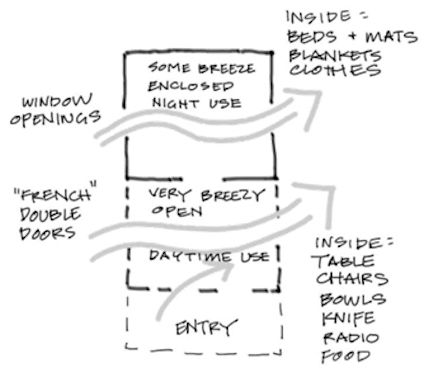 A gallery at the narrow gable end of a kay always faces the road or path. An extended gable above it is used for storage. This ‘soute’ can be locked and accessed from inside or out. Larger porches are sometimes added to wrap one or both sides of the house. But the entrance is always through the often lavishly decorated gallery that faces the street.
A gallery at the narrow gable end of a kay always faces the road or path. An extended gable above it is used for storage. This ‘soute’ can be locked and accessed from inside or out. Larger porches are sometimes added to wrap one or both sides of the house. But the entrance is always through the often lavishly decorated gallery that faces the street.
The basic square room shape of the kay (10 x 10’ to 12 x 12’) is a good structural module for safe construction. Earthbag walls in this size and shape are strong and earthquake resistant when they are tied together with an adequate bond beam.
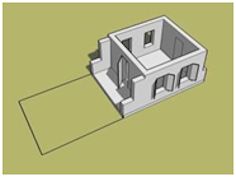 A lintel support above a door or window opening can be concrete cast in place, or made from wood or metal. Because it is difficult to cut openings in earthbag after the soil cures, a doorway at the rear can be framed out for the future and then filled with earthbags that are not woven into the rear wall.
A lintel support above a door or window opening can be concrete cast in place, or made from wood or metal. Because it is difficult to cut openings in earthbag after the soil cures, a doorway at the rear can be framed out for the future and then filled with earthbags that are not woven into the rear wall.
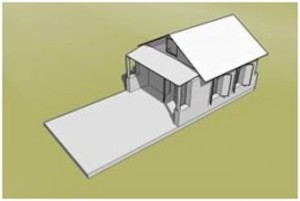 The basic room at left can serve as a shelter now, and grow into a larger house later. The basic kay shape will be easier to add on to later if stepped piers are left where the walls will extend in the future. Additive construction is safe when each unit ties into the previous and follows the same structural form.
The basic room at left can serve as a shelter now, and grow into a larger house later. The basic kay shape will be easier to add on to later if stepped piers are left where the walls will extend in the future. Additive construction is safe when each unit ties into the previous and follows the same structural form.
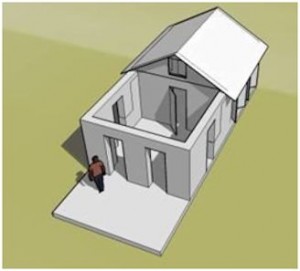 A tarp can be added to keep rain off of the entrance at this first stage. Doors and shutters will be desired early because many Haitians fear openings at night.
A tarp can be added to keep rain off of the entrance at this first stage. Doors and shutters will be desired early because many Haitians fear openings at night.
The next room built will be the salle or main living space. This is traditionally the breeziest room of the ti-kay, with 3 or 4 outside doors.
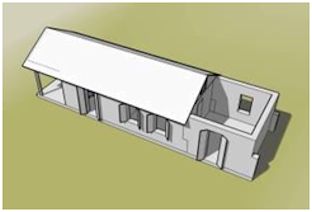 For Haitians the gallery is their main living space, and this porch will be built next. After the gallery is roofed over, another addition can be started at the rear of the building. Earthbag walls can be built little by little as long as they are not exposed to the sun for longer than a month. If earthbag walls are not roofed over immediately, they can be covered with a tarp to keep the sun off of the bags. After walls are plastered and roofing is finished, they can be painted in bright colors. Haitian carpenters can embellish them with trim just as any other kay.
For Haitians the gallery is their main living space, and this porch will be built next. After the gallery is roofed over, another addition can be started at the rear of the building. Earthbag walls can be built little by little as long as they are not exposed to the sun for longer than a month. If earthbag walls are not roofed over immediately, they can be covered with a tarp to keep the sun off of the bags. After walls are plastered and roofing is finished, they can be painted in bright colors. Haitian carpenters can embellish them with trim just as any other kay.
Copyright 2010 Patti Stouter.
This work can be used according to the Creative Commons Attribution Non-commercial License 3.0 You are free to share (copy, distribute and transmit) the work and to remix or adapt it under the following conditions: attribution (you must attribute the work in the manner specified by the author (but not in any way that suggests that they endorse you or your use of the work) and Non-commerical (not for any commercial purpose). These conditions can be waived with permission from the copyright holder.

